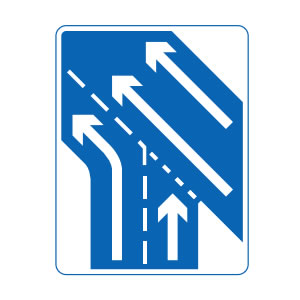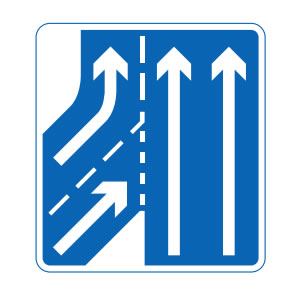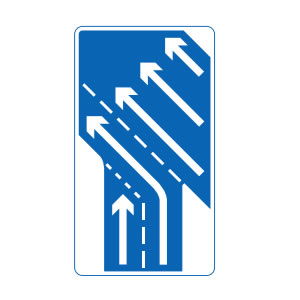Joining a motorway is usually done via the use of the motorway slip road, or an acceleration lane and can make many of us nervous, especially if you have never done this before.
It could be that you have never lived near a motorway, have never had the need to travel on one, or have simply just passed your driving test. This guide is intended to help build motorway driving confidence by providing tips, the correct procedure and rules for joining a motorway by use of a motorway slip road. Signs for merging onto a motorway are also provided.
Motorway slip road – joining a motorway
Motorways may be joined from a roundabout or a main A road. Joining the A road or roundabout to the motorway is the slip road. The slip road is used to adjust your speed to fit in with the traffic already on the motorway. It’s important that you do not impede the traffic on the motorway in any way as this increases the risk of accidents.
As you enter the motorway slip road, try to assess the condition of the motorway you wish to join from as early as possible. Keep a keen eye for slow moving traffic that could indicate congestion at some point in the motorway. If the traffic seems to be free flowing, they will be driving at speeds of around 60 to 70 mph and this is the speed you will need to reach in order to join safely. Ensure you do not enter the motorway at a slow speed. This may seem safer for a nervous driver but is extremely dangerous.
Whilst accelerating down the slip road, again, as early as possible, look at what traffic is approaching in the left lane – the lane you are going to join. You will need quick glances over your right hand shoulder to gain a good view of the approaching traffic, along with frequent glances ahead to keep a check on where you are going and also into your right hand mirror.
This can seem difficult to all fit in due to the high speeds but constant, frequent and quick glances in all these areas are essential. The key is to keep assessing the traffic flow as you are accelerating down the slip road and to ‘mark your spot’. Try and find a gap with plenty of room to fit your car in.
Once you have marked your gap, you may need to accelerate more or slow down slightly to fit in. If the motorway is busy in the left lane, traffic will see you approaching and will often either slow down to allow a bigger gap for you to enter or they may move over a lane to let you in.
Try to avoid at all costs stopping at the end of the slip road as it can be highly dangerous trying to enter the motorway from a stationary position.
Around half way down the slip road, indicate to the right to allow traffic on the motorway a clearer view of what your intention to join. When joining the motorway, keep in the left lane until you have safely adjusted to the speed of the traffic. Ensure you cancel your signal once you have joined to eliminate any confusion.
Whilst taking the slip road, another observation you will need to include is to look for motorway signs. Motorway signs can indicate which lane you may need to take and if you need to give way.
Motorway slip road signs

Traffic on the main carriageway coming from right has priority over joining traffic

Additional traffic joining from left ahead. Traffic on main carriageway has priority over joining traffic from right hand lane of slip road

Traffic in right hand lane of slip road joining the main carriageway has priority over left hand lane
-
Motorway sign A
The above sign ‘A‘ on the left is a common sign you may see entering a slip road to a motorway. A slip road with this sign will be divided into two lanes. The left hand lane on the slip road will have a dedicated lane on the slip road itself and on the motorway. Keeping to the left lane on a slip road with this sign is the safest way to join the carriageway as it is far less likely you will need to give way to the right. Caution still needs to be taken for cars in the right slip lane entering your lane and for cars already on the motorway entering the left lane.
On occasions, the left lane may have a solid line separating it from the other lanes. If this is the case, you will not be able to move into another lane until the solid line has finished and other vehicles are not permitted into this lane. The slip road right lane will need to give way to the right for oncoming traffic on the motorway.
-
Motorway sign B
Sign ‘B‘ is for traffic already on the motorway warning them that that a slip road is approaching, an additional lane will be in use for traffic joining the motorway and that traffic from the right hand lane on the slip road may be joining your lane.
-
Motorway sign C
Motorway sign ‘C‘ is less frequent on motorways. This time, the right hand lane has priority over the left hand slip road lane and the right lane also has its dedicated lane when entering the motorway. Traffic in the left lane on the slip road will have to give way to traffic in the right hand slip road lane.
What to do when Merging onto a motorway
- Assess the traffic speed on the motorway as early as possible when joining the slip road
- Reach a similar speed as those on the motorway before joining
- Quick and frequent glances over your right shoulder, right mirror and ahead
- Keep a close eye on road markings and avoid crossing solid white lines
- Choose an appropriate gap whilst accelerating down the slip road and adjust your speed accordingly
- Signal to the right to tell others you are joining
- Join the motorway in the left lane and cancel your signal
What not to do when Merging onto a motorway
- Joining the motorway at too slow speed can be dangerous
Maintain a safe following distance
A safe following distance is especially important on high speed motorways. Once you join the carriageway, it is possible that you are a little too close to the vehicle in-front. As soon as is safely possible, increase your following distance by using the 2 second rule technique. This technique can be used to establish the minimum safe following distance at any speed.
GUIDES AND TUTORIALS RELATED TO MOTORWAY DRIVING
- Motorway overtaking
- Motorway light signals
- Motorway rules
- Motorway road signs
- Motorway driving
- Motorway reflective studs
